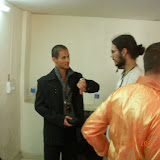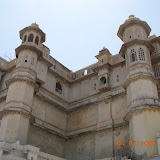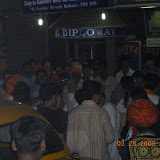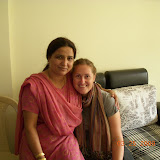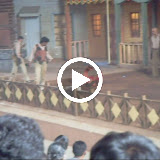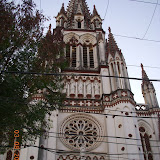Despite our fatigue, we managed to find an ATM and a pre-paid taxi to take us from the airport into town. The guesthouse that the book recommended had clean, albeit small, rooms at a good price. We threw our stuff down and stepped out to grab some food before hitting the sheets. There was a wealth of food options right outside our door, and we settled on the noodle bowls that a friendly old woman was selling. We weren’t sure at first what to order, but the woman pointed, indicating that we should choose a type of noodle, a type of meat, and then sit down. Each bowl of noodle is served with a spoon, a set of chopsticks, and four condiments for seasoning; red chili, vinegar with peppers, fish sauce, and sugar. We experimented until we found the perfect blend of spices and then dug in. A delicious meal for under a dollar. So far, Thailand was looking good.

We walked out on to the main road to find a new SIM card for the cell phone, and found a 7-Eleven right around the corner. How convenient! While Leon was checking out the SIM card selection, I was checking out the street, and what was the first thing that I spotted when I looked out the front door? A 7-Eleven! There was another one right across the street! Yes, 7-Elevens are in Thailand what Starbucks is in America. They are everywhere. There are two inside the Bangkok bus station.
The other thing that we noticed on the street, were vendors, dozens of them, selling nothing but water guns. We had read on the plane about the Thai New Year celebration called Songkran. Traditionally, the festival is about cleansing and honoring your elders and it is celebrated with a ritual spraying of water. We set off down the street, smiling at the vendors and giggling as small children shyly sprayed their guns at us before hiding behind their parents. As Leon put it, it was little squirts from little squirts. Nothing to be afraid of. Then we rounded the corner, and a kindly old woman wished us a happy new year before dumping a bucket of water over our heads. We were drenched, and this was war!

We made a beeline back to the hotel room (dodging water the whole way) to put away anything valuable, then headed out to buy waterproof wallets and super-soakers. One block from our hotel, we found Ko San Road and the heart of the Songkran celebration. We joined the crowd of revelers roaming the streets. Everywhere there were people spraying water guns, or smearing mud (another ritual apparently). Vendors lined the streets selling food, drinks, mud, and water gun refills to keep the party fueled. After a few hours of playing, we went back to the hotel, wrung out our clothes and finally slept.
The second day we headed out for another day of celebrating with the crowds. We put on our clothes, which were still a little damp from the day before, grabbed some fried rice and entered the fray. We walked for blocks and as we neared the center of town, we looked up to see a plume of black smoke. We stopped to ask a local man what was happening. He told us not to worry, it was the red shirts and it was under control. Unaware of the political situation that was unfolding, we thought he meant that it was a controlled fire put on by the fire department; just part of the celebration. Still, something seemed off, so we turned and began walking back the other direction.
A few blocks later, we stopped for a beer on a busy patio. We struck up a conversation with some British girls and were having a relaxing afternoon when we were interrupted by a tourist with a loudspeaker. She said that she was interpreting for the police, and had been instructed to tell all foreigners to head back to their hotel rooms. It was unsafe for us to be on the streets, and the police would be by shortly to close the bar. Leon and I looked at each other nervously, downed our beers and prepared to leave. Everyone else at the bar acted as though nothing had happened. The British girls told us about the protests, and said that such announcements are common. They assured us that we weren’t in any danger, the police were just following procedure, CYA. We decided to be safe and move closer to our hotel. If there was no problem, then no problem; but if there was a problem we would be close to safety.

We stopped into the guesthouse and asked the owner about the protest. “Don’t worry. You safe.” The news on the television was in Thai, and from what we have heard pretty censored, so we decided to check the internet for stories about what was happening in town. The NY Times was showing the damage on the front page, and it turns out the “controlled fire” we had seen earlier was a burning bus. We logged on to the State Department website, and filled in the Embassy form to notify them of our location and contact information, and decided that it was time to get out of Bangkok. We bought bus ticket to Koh Pha-ngan that left the following evening.
Our last day in Bangkok, we wandered the area near the palace. The palace itself was closed for the holiday, but the amulet market just outside the walls was open and we spent hours looking for the perfect ones. Next to the palace is a center for Buddhist Education, and they were having a festival for Songkran. Food vendors and craftsmen from all over the country had gathered. We walked around sampling the culinary delights and learned about the traditional celebration of Songkran. We also got a chance to see the famous reclining Buddha (the world’s largest) before heading back to the hotel and away from the city.

It was interesting to be in Bangkok when we were. Between the Songkran Festival and the protests, our visit to the city was hardly normal. Strangely, we didn’t feel like we were in danger in Bangkok until we left. Even then, we thought that the news reports sensationalized the situation, and made things seem more dangerous that they were. We will return to the city before we leave Thailand, and I am curious to see the differences.
 |
| Bangkok |
